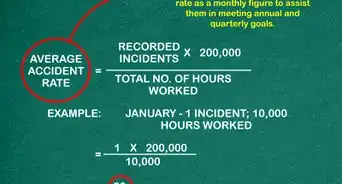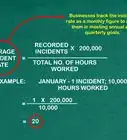This article was co-authored by Michael R. Lewis. Michael R. Lewis is a retired corporate executive, entrepreneur, and investment advisor in Texas. He has over 40 years of experience in business and finance, including as a Vice President for Blue Cross Blue Shield of Texas. He has a BBA in Industrial Management from the University of Texas at Austin.
There are 9 references cited in this article, which can be found at the bottom of the page.
This article has been viewed 111,923 times.
Financial risk is inherent in the field of investment. Risk is the chance that an investment will lose money or that it will grow much more slowly than expected. To reduce financial risk to yourself, you must learn how to manage your investment portfolio well. There are several techniques involved in effective portfolio management.
Steps
Understanding Financial Risks
-
1Familiarize yourself with the different types of risk. Most financial risk can be categorized as either systematic or non-systematic. Systematic risk affects an entire economy and all of the businesses within it; an example of systematic risk would be losses due to a recession. Non-systematic risks are those that vary between companies or industries. These risks can be minimized through careful planning.[1]
- Interest rates, wars, and economic recession may factor into systematic risk. Systematic risk can be buffered by hedging.
- Non-systematic risk is also known as "unique risk" because it applies to one company.
- In general, the more risk you take on as a part of your financial investments, the more profit you stand to gain. Because you can't predict when these gains will occur, however, careful planning is required to know how much risk you can afford.
-
2Understand systematic risk. There are several types of systematic risk, but the primary quality of systematic risk to consider is that diversifying your portfolio will have limited effect on systematic risk. This manner of risk is also known as "market risk" or "undiversifiable risk" due to its pervasiveness throughout the economic market.[2]
- Interest risk is the risk that changing interest rates will make your current investment's rate look unfavorable.
- Inflation risk is the risk that inflation will increase, making your current investment's return smaller in relation.
- Liquidity risk is associated with "tying up" your money in long-term assets that cannot be sold easily.
Advertisement -
3Learn about non-systematic risk. Non-systematic risk refers to the hazards of investment within a given company or business. Some examples of non-systematic risk include product recall, management change, the growth of a new competitor or regulatory change. These are risks that can be managed by minimizing your exposure to any given business or business sector, because any loss will be contained.
- Two examples of non-systematic risk categories include management risk and credit risk. Management risk is the possibility that bad management decisions will hurt a company in which you're invested. Credit risk is the chance that a debt instrument issuer (such as a bond issuer) will default on their repayments to you.
- Keeping different kinds of stocks from a variety of companies helps to defray the risks associated with non-systematic risk.
-
4Know the difference between asset classes. Most financial assets can be categorized as stocks, bonds, real estate or cash. Each category comes with its own benefits and limitations.
- Cash is the simplest asset, and its main risk is the rate of inflation.
- Bonds are relatively secure, but they are subject to interest rate as well as liquidity risks (systematic risk), meaning you may not be able to convert them to cash when you need to.
- Stocks are the most risky investment for a short time period — the fluctuation of the market is a considerable systematic risk — but they often provide a steady income over the long term.
- Real estate values are relatively stable, though may increase or decrease over time. You may not be able to sell as swiftly as you'd like — real estate is generally considered not to e liquid.
-
5Understand asset-based financial risk. Different kinds of risks apply to different asset classes. For example, in a home loan, the bank is essentially issuing a bond to the mortgage holder in the form of a loan. The bank's profit comes from the interest rate applied to the mortgage. If the mortgage is paid off early, the bank loses the expected income.
- Interest risk rates can change over time, resulting in interest rate risk. If you have a variable interest rate on a loan, you take on the risk that an increased interest rate will change your prospective purchase price.
- Market risk is the chance that an asset will lose value over time.
- Liquidity risk is the risk that an asset or security won't be able to be converted into cash within a necessary time frame.
Diversifying Your Holdings
-
1Determine the level of risk associated with your varied investments. Before reducing risk, you must understand how much risk you can expect from each type of investment. Consider the purpose of your investments, and the amount of risk you can afford to carry on each one.
- Stocks are some of the riskiest investments, but can also provide the highest return. Stocks carry no guarantee of repayment, and changing investor confidence can create market volatility, driving stock values down.
- Bonds are less risky than stocks. Because they are debt instruments, repayment is guaranteed. The risk level of a bond is therefore dependent on the credit worthiness of the issuer; a company with shakier credit is more likely to default on a bond repayment. You must also take into account the interest rate risk, which affects bonds more than it affects stocks.[3] A rising interest rate means a falling bond price.[4]
- Cash-equivalent investments, such as money market accounts, savings accounts, or government bonds are the least risky. These investments are also highly liquid, but they provide low returns.
-
2Determine the level of risk you are willing to shoulder. When deciding on an overall level of risk, you need to assess how you want to use the money from your investments in the future.[5]
- If you are planning a big expenditure in the near future (such as a house or tuition), or you are retiring soon, you should aim for a relatively low-risk portfolio. This will help ensure that market volatility doesn't cause your investments to lose a lot of value just before you need to draw money from them.
- If you are investing for a long-term goal, more risk is appropriate. Long-term goals allow you to wait out stock price fluctuations and realize high returns over the long run.
-
3Reduce your portfolio's risk level by allocating assets widely. The first key to lowering risk is to allocate your money between different investment classes. Your portfolio should include stocks, bonds, cash equivalents, and possibly other investments such as real estate. The proportion of these allocations will depend on the level of risk you want to shoulder overall.
- Allocating assets widely hedges against the risk that certain asset classes will perform well while others perform poorly.
- Spreading investments between stocks and bonds will protect against the risk of either category performing poorly.
- Consider using an online asset allocation calculator, such as the one available through the Iowa Public Employees Retirement System. These tools provide a good framework for understanding ways to allocate your own funds, even though your individual choices will likely vary.
-
4Understand hedging. A great way to mitigate the inherent risk of investing is to hedge your investment. The idea is to protect or balance out the risk of one vulnerable asset by investing in something that, should the vulnerable asset suffer a loss, the other asset will experience a gain. It may not entirely offset the loss you experience, but it can reduce it.[6] [7]
- Hedging is not free, and the idea is not to make money from this investment, rather, it is to protect yourself. Consider, for instance, the insurance you pay on your car. If you get in an accident, your insurance may save you hundreds or even thousands of dollars in repairs. On the other hand, you may never get into an accident, but you will have made those insurance payments, just in case.
- Learn more by reading How to Hedge in Investments.
-
5Lower each asset type's risk through diversification. Diversifying your portfolio means buying a single type of asset from many different companies. This hedges against the risk that a single company or industry will perform poorly or go bankrupt.[8]
- For example, if you buy stocks in 30 different companies, it is not likely that all 30 will perform poorly or go bankrupt at once, barring an economy-wide downturn. However, if you used the same amount of money to invest in only one company's stock, the company may perform poorly and drag your entire stock portfolio down with it.
- Remember that diversification can't protect against systematic risks.
- To diversify your portfolio, consider an exchange-traded fund (EFT). An EFT is like a mutual fund in that it is an index of assets (bonds, stocks, futures, etc.), but unlike a mutual fund, it can be traded like a common stock and has a higher liquidity.[9]
Planning for Your Time Horizon
-
1Consider your time horizon. Your financial time horizon is a set date, usually months, years or even decades in the future, at which time you will achieve your financial goal. A common time horizon is a retirement date. If you have a longer time horizon, you may feel more comfortable taking on riskier financial decisions. If your time horizon is relatively short, you may need to minimize risk.[10]
- An example of a shorter time horizon would be a teenager saving for his college education, or someone in their 50s planning for retirement.
- Long-term investors should be willing (and able) to "ride out" the low points of financial return, i.e., periods when their assets have lost value.
- Holding an asset longer doesn't necessarily result in increased value.
-
2Think about your risk tolerance level. Your risk tolerance is based on your ability — financial as well as emotional — to lose much of your original investment in exchange for greater potential returns.[11]
- Your risk tolerance will change over the course of your lifetime, though your temperament may not.
- Someone with a higher risk tolerance may take on more aggressive (and risky) investments, while someone with a lower risk threshold will be happier with a less risky investment, even if it results in lower returns.
- Think of your risk tolerance level in terms of sleep — anything that causes you to worry and lose sleep at night should be avoided. If there's an investment that keeps you up at night worrying, then you've taken a bigger risk than you're currently prepared to take.
-
3Change your asset allocation when necessary. If your time horizon changes, or your life circumstances alter your risk tolerance level, you may wish to change the manner in which you allocate your assets. This is known as "rebalancing" and it occurs when your investments are no longer in line with your investment goals. Many investors choose to readjust their investments on an annual or semi-annual basis.
- Rebalancing may trigger transaction fees or tax consequences.
- Avoid changing your asset allocation based on performance. Remember that if a given asset isn't doing well, it will likely increase in value in the future. Remember the old adage: buy low, sell high.
Warnings
- There is no way to completely eliminate risk from financial investment.⧼thumbs_response⧽
References
- ↑ http://www.learningmarkets.com/understanding-systemic-risk/
- ↑ http://www.investopedia.com/walkthrough/corporate-finance/4/return-risk/systematic-risk.aspx?no_header_alt=true
- ↑ http://www.investopedia.com/terms/i/interestraterisk.asp
- ↑ http://www.investopedia.com/terms/i/interestraterisk.asp
- ↑ http://www.nasdaq.com/investing/risk/risk-preference.aspx
- ↑ http://www.investopedia.com/articles/basics/03/080103.asp
- ↑ http://www.investopedia.com/terms/h/hedge.asp
- ↑ http://www.finra.org/investors/diversifying-your-portfolio
- ↑ http://www.investopedia.com/terms/e/etf.asp

































































